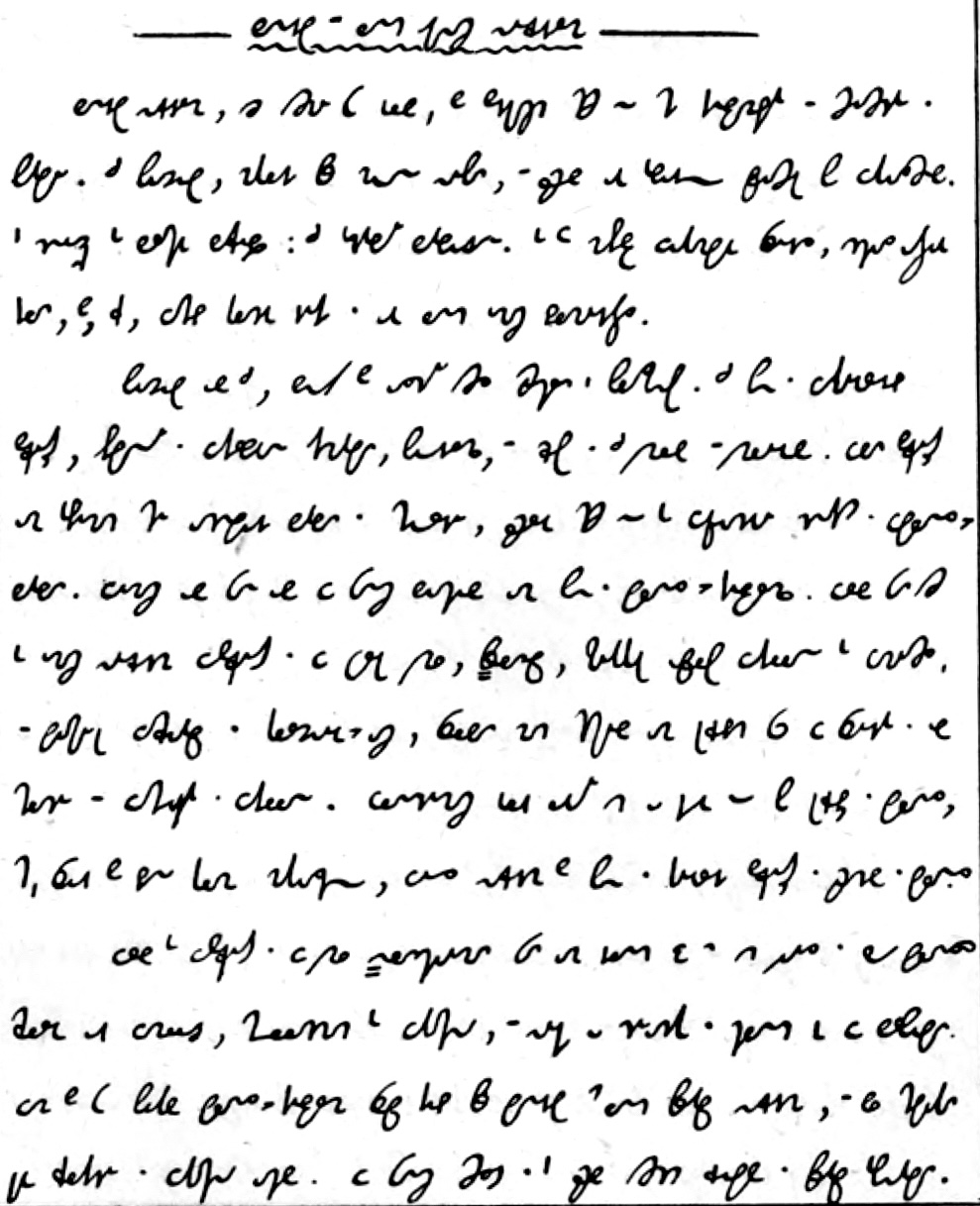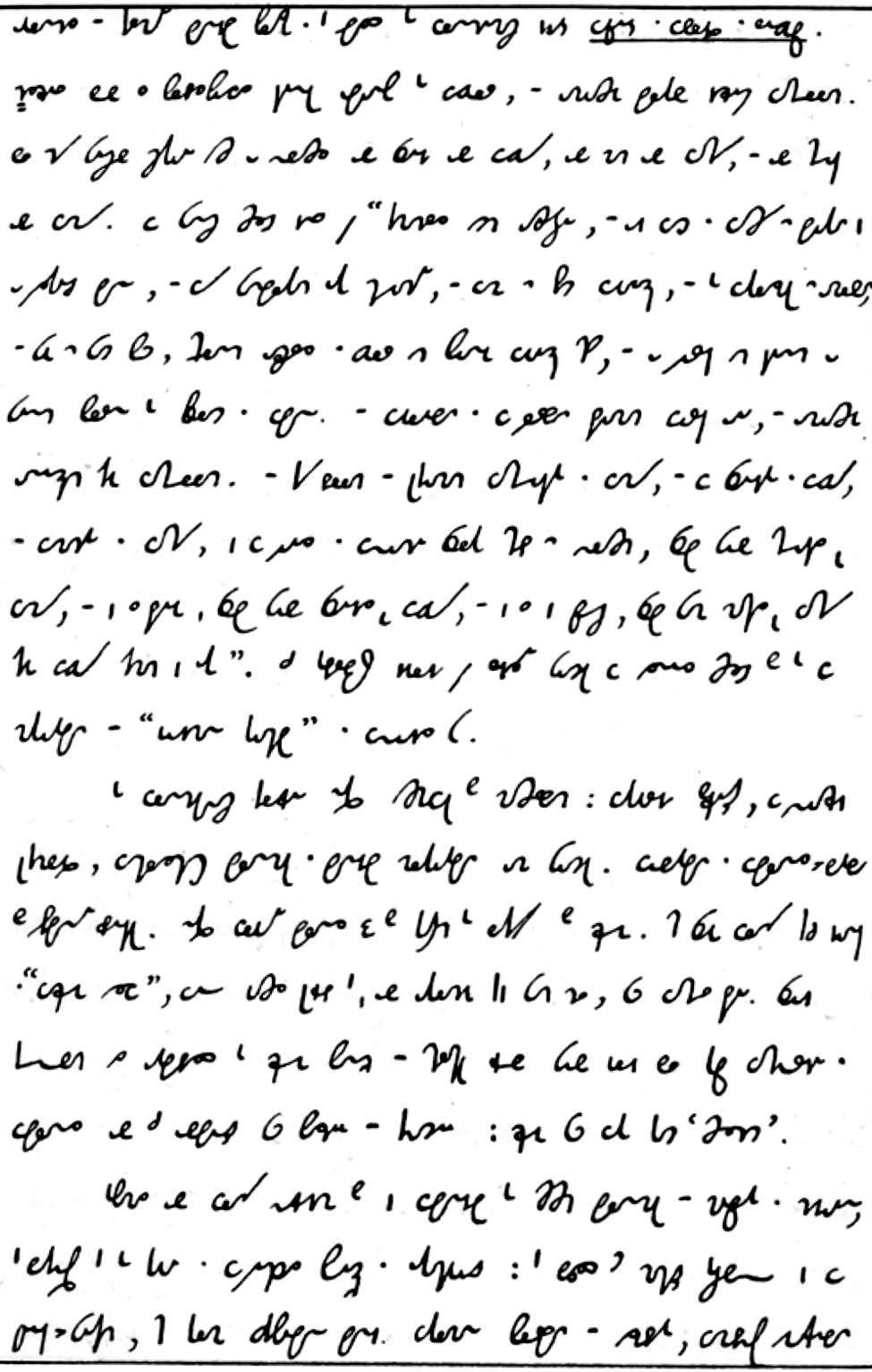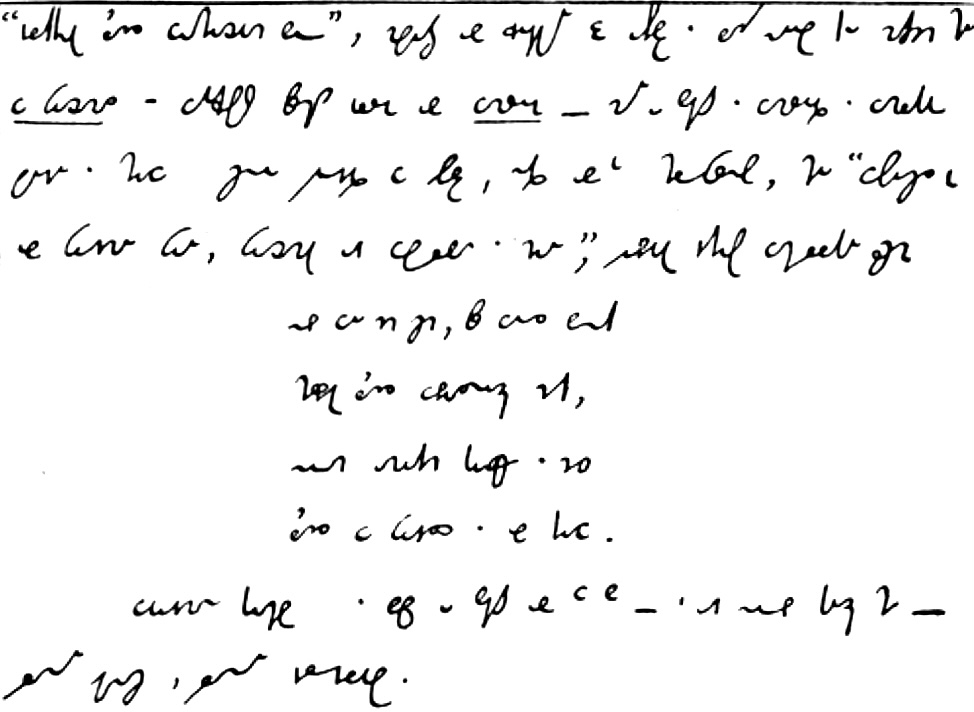Orthographic Current Shorthand
- The Alphabet
- General Principles
- Vowels
- Arbitraries
- Consonants
- Projection Indicates Articulation
- Form Indicates Quality
- Consonants Requiring Special Notice
- Consonant-Groups
- nt, mp, nk; nd, mb
- pt, kt; bt, g(h)t; ft, ct, tht
- pf, ck
- s before
- s after
- s after vowels
- les, res
- loop z and cross-loop s after curved-foot consonants
- -ses
- back-hook for final s
- -hs, -qs, -ques
- thr, thw
- forward-ring w
- obvious ligatures
- raised short consonant beginning a consonant group
- other ways to form ligatures
- Rising Consonants
- List of Characters
- Contraction
- Specimens
The Alphabet
The following is the elementary alphabet of Orthographic Current Shorthand:

General Principles
Consonants are expressed by full-sized characters, such as
 s,
s,
 t,
vowels by small characters, as in
t,
vowels by small characters, as in
 sit.
i is a ‘high-mid’ vowel.
Some vowels are written at the ‘low-mid’ level, such as o,
as in
sit.
i is a ‘high-mid’ vowel.
Some vowels are written at the ‘low-mid’ level, such as o,
as in
 not.
not.
The only consonant that is written small is L,
expressed by low-mid  before vowels,
by high-mid
before vowels,
by high-mid  after vowels,
as in
after vowels,
as in
 lot,
lot,
 salt.
salt.
The other consonants are distinguished by their ‘projection’.
‘Short’ consonants, such as
 ,
,
 ,
,
 ,
do not project at all.
The ‘long’ consonants are either
‘high,’ such as
,
do not project at all.
The ‘long’ consonants are either
‘high,’ such as
 b,
‘low,’ such as
b,
‘low,’ such as
 c,
or tall, such as
c,
or tall, such as
 tt.
Examples:
tt.
Examples:
 bin,
bin,
 cat,
cat,  cab,
cab,  bitten.
bitten.
If the vowel before or after a consonant is not
written, the stroke is used to show the presence of a vowel — generally e — as in
 else.
else.
When two consonants come together without any vowel between,
forming a ‘consonant-group,’
they are, if possible, joined together without any stroke, as in
 ,
where ls forms a ‘ligature.’
,
where ls forms a ‘ligature.’
If this cannot be done,
they are crowded together,
or written detached and close together,
as in
 ,
,
 Etna,
or else ‘grafted’ together,
as in
Etna,
or else ‘grafted’ together,
as in
 Camden.
Camden.
But many consonant-groups are expressed by simple characters,
such as
 th
in
th
in
 thin.
Such groups as st, ts, are expressed by joining the loop of the s directly on to the t, as in
thin.
Such groups as st, ts, are expressed by joining the loop of the s directly on to the t, as in
 state
state
 lets.
lets.
A consonant-character standing alone is used as a ‘sign,’
that is, a contraction of some special word,
or of several words pronounced alike.
Thus
 = to, too, two,
= to, too, two,
 = the,
which is however generally joined on to the following word, as in
= the,
which is however generally joined on to the following word, as in
 the cat.
the cat.
Some signs are made by writing ‘in position’,
that is, raised or lowered above or below the line of writing.
Thus raised
 = it,
lowered
= it,
lowered
 = than.
= than.
Vowels
-
 e, ee.
e, ee.
 let;
let;
 seen.
Most medial (in the interior of a word) unaccented vowels may also be expressed by the short stroke:
seen.
Most medial (in the interior of a word) unaccented vowels may also be expressed by the short stroke:
 canal,
canal,
 singing.
singing. -
 i.
i.
 imitate,
or, using the short stroke for the medial i,
imitate,
or, using the short stroke for the medial i,
 .
. -
 a.
a.
 a man.
When convenient, may be written inside the curve of some consonants:
a man.
When convenient, may be written inside the curve of some consonants:
 vain.
vain. -
 y.
y.
 gypsy.
The shorter i may generally be written instead:
gypsy.
The shorter i may generally be written instead:
 “gipsi,”
“gipsi,”
 city (literally ‘citi’),
city (literally ‘citi’),
 day (literally ‘dai’).
day (literally ‘dai’). -
 œ.
œ.
 phœnix,
or, using the short stroke for the medial i,
phœnix,
or, using the short stroke for the medial i,
 .
. -
 e, ee.
These characters are only occasionally written instead of the stroke, as in
e, ee.
These characters are only occasionally written instead of the stroke, as in
 true.
Full e is often more distinct finally
(at the end of a word)
than the stroke, as in
true.
Full e is often more distinct finally
(at the end of a word)
than the stroke, as in
 fine
distinguished from
fine
distinguished from
 fin.
Full ee is sometimes more distinct than the long stroke.
[No example is provided.]
fin.
Full ee is sometimes more distinct than the long stroke.
[No example is provided.] -
 æ.
æ.
 Cæsar.
Cæsar. -
 u.
The second form is used when u is written detached, to distinguish it from
u.
The second form is used when u is written detached, to distinguish it from
 r.
r.
-
 o.
o.
 soul.
Detached
soul.
Detached  = o!
= o! -
 w.
Used only to express w after a vowel, as in
w.
Used only to express w after a vowel, as in
 saw,
saw,
 now.
In all familiar words u may be substituted:
now.
In all familiar words u may be substituted:
 ‘sau,’
‘sau,’
 ‘nou.’
‘nou.’
Lengthening
Lengthening a vowel-character implies preceding e:
-
 ei.
ei.
 vein.
vein. -
 ea.
ea.
 ,
,  easy.
easy. -
 ey.
ey.
 they.
In most cases ei may be written instead:
they.
In most cases ei may be written instead:
 .
. -
 eu.
eu.
 Europe.
Europe. -
 eo.
eo.
 people.
people. -
 ew.
ew.
 Carew.
In most words eu may be substituted:
Carew.
In most words eu may be substituted:
 new (literally “neu”).
new (literally “neu”).
ie, oa
-
 is used to express ie, as in
is used to express ie, as in
 piece.
In the combination ieu the i is written separately,
and the e is implied by lengthened u:
piece.
In the combination ieu the i is written separately,
and the e is implied by lengthened u:
 lieutenant.
lieutenant. -
 may be used to express oa:
may be used to express oa:
 oatmeal.
oatmeal.
Detaching
In the combination aa the two vowels
must be written detached:
 Isaac.
So also in such combinations as
Isaac.
So also in such combinations as
 lying.
lying.
When a low vowel has to be detached after a high one,
it is written immediately under the high one:
 guard.
guard.
Arbitraries
The following arbitrary marks, written like vowels, are used to express certain very common words:
-
 and.
Compare the use of the hyphen (-) in ordinary writing.
and.
Compare the use of the hyphen (-) in ordinary writing. -
 or.
or. -
 of.
of.
Examples:
 now and then;
now and then;
 now or never;
now or never;
 a piece of cake.
a piece of cake.
Consonants
Projection Indicates Articulation
The projection of a consonant-character shows the place in the mouth where the sound it generally represents is formed.
Short = Point
The point (tongue-point) consonants are written short:
 t,
t,
 d,
d,
 n;
n; s,
s,
 z;
z; th;
th; r.
r.
Examples:
 detain,
detain, seize,
seize, the rat.
the rat.
Signs:
 = to(o), two;
= to(o), two;
 = it
= it = twice;
= twice;
 = its, it is (it’s)
= its, it is (it’s) = on;
= on;
 = in;
= in;
 = than
= than = is
= is = the, thee;
= the, thee;
 = this
= this
High = Lip
The lip-consonants are written high:
 p,
p,
 b,
b,
 m;
m; f,
f,
 v;
v; w (as in we),
w (as in we),
 ph.
ph.
Examples:
 problem,
problem, five,
five, wolf,
wolf,
 sylph.
sylph.
Signs:
 = but
= but = for, fore, four
= for, fore, four = won, one
= won, one
Low = Back
The back-consonants are written low:
 k,
k,
 c,
c,
 g,
g,
 ng;
ng; qu (= kw),
qu (= kw),
 x (= ks).
x (= ks).
So also:
 y (as in you)
y (as in you)
 j, and
j, and
 sh.
sh.
because they are formed further back in the mouth than the point-consonants.
Examples:
-
 king,
king,  cook,
cook,  going
going -
 queen,
queen,  six
six -
 rejoice,
rejoice,  youngish
youngish
Signs:
 = because
= because = again
= again = quite
= quite = you
= you
Tall = Doubled Point
The tall consonants indicate doubling of the corresponding short or small ones:
 tt,
tt,
 dd,
dd,
 nn;
nn; ss,
ss,
 zz;
zz; rr,
rr,
 ll.
ll.
Examples:
-
 ditto,
ditto,  middle,
middle,  penny
penny -
 less,
less,  buzz
buzz -
 sorry,
sorry,  tell,
tell,  silly
silly
Form Indicates Quality
The other classes under which consonants fall are partly indicated by their form:
| hard: |  t t |
 p p |
 k k |
 s s |
 f f |
|---|---|---|---|---|---|
| soft: |  d d |
 b b |
 g g |
 z z |
 v v |
| nasal: |  n n |
 m m |
 ng ng |
Consonants Requiring Special Notice
Some of the consonants require special notice.
H
h is generally expressed by the low stroke when initial (at the beginning of a word):  hat.
hat.
Non-initial h is expressed by
 as in
as in
 ah!,
the stroke being drawn through the character, as with
ah!,
the stroke being drawn through the character, as with
 qu,
when convenient:
qu,
when convenient:
 behalf.
behalf.
This character also forms part of the ligatures:
 kh as in
kh as in
 khan,
khan, ch as in
ch as in
 cheque,
cheque, gh as in
gh as in
 laugh,
laugh, rh as in
rh as in
 rhyme,
rhyme, wh as in
wh as in
 when.
when.
Medial h may be expressed by drawing a stroke through the preceding character, as in
 ,
,  behave.
behave.
Signs:
 = how
= how
L
L has been partly explained under ‘General Principles’.
Long high
 = eel,
long low
= eel,
long low
 = lee,
as in
= lee,
as in
 feel,
feel,
 bleed,
the stroke being prefixed to initial eel and added to final lee:
bleed,
the stroke being prefixed to initial eel and added to final lee:
 eel,
eel,
 Lee,
Lee,
 glee.
glee.
After a long vowel
the L may
be lengthened instead of the vowel, as in
 veil.
veil.
The stroke before low L must be written under the line:
 elect.
elect.
L is also expressed by the upright
 ,
which always implies a following vowel,
expressing ‑le when final:
,
which always implies a following vowel,
expressing ‑le when final:
 mile.
It is necessary when vowel + L is followed by a low vowel, as in
mile.
It is necessary when vowel + L is followed by a low vowel, as in
 felon,
unless a break
(
felon,
unless a break
( fel/on)
or contraction
(
fel/on)
or contraction
( feln)
is made.
feln)
is made.
In the combination consonant + L + vowel,
the L may be implied by lengthening the stroke before the vowel:
 slip,
slip,
 float.
Hence initial
float.
Hence initial
 may be used to express loa, as in
may be used to express loa, as in
 load.
load.
Signs:
 = all
= all = always
= always = below
= below
R
r when final or followed by a consonant is expressed by
 ,
which is run on to t, n, etc.:
,
which is run on to t, n, etc.:
 terror,
terror,
 word,
word,
 heart,
heart,
 burn.
burn.
Before such consonants as s it may be written as an upward loop run on to the consonant:
 curse,
curse,
 force.
force.
Final
 always implies a following vowel:
always implies a following vowel:
 here.
here.
r is added to straight-stem consonants in the form of a ‘back ring,’ as in
 tr:
tr:
 true,
true,
 pride,
pride,
 green,
green,
 street.
street.
Consonants
ending in rising loops add r as in
 fr:
fr:
 fruit:
fruit:
 phrase,
phrase,
 Nimrod,
Nimrod,
 creature.
creature.
r is simply crowded on after down-loop consonants such as
 sh:
sh:
 shrill.
shrill.
nr is best written grafted, as in
 Henry.
Henry.
Signs:
 = her
= her = perhaps
= perhaps = from
= from
Consonant-Groups
As we have seen, many consonant-groups are expressed by simple characters, not only when they express simple sounds, such as sh, but also when they express compound sounds, such as x. The following consonant-groups are also expressed by simple characters:
nt, mp, nk; nd, mb


 nt, mp, nk;
nt, mp, nk;
 nd, mb.
nd, mb.
Examples:
 tent,
tent,
 lamp,
lamp,
 ink;
ink; find,
find,
 number.
number.
Signs:
 = unto
= unto = into
= into = under
= under
pt, kt; bt, g(h)t; ft, ct, tht
 pt,
pt,
 kt;
kt; bt,
bt,
 gt (but more often used for ght);
gt (but more often used for ght); ft,
ft,
 ct,
ct,
 tht.
tht.
Examples:
 adapt;
adapt; debt,
debt,
 bright.
bright. left,
left,
 fact.
fact.
Signs:
 = about
= about = against
= against = that
= that
pf, ck
 pf
pf ck
ck
Examples:
 Pfeiffer
Pfeiffer cackle
cackle
s before
s is prefixed to another consonant by means of a loop.
Examples:
- As a high anti-clockwise loop before the straight stem consonants:
 st as in
st as in
 stand
stand sp as in
sp as in
 spread
spread sk as in
sk as in
 task
task
- As a high clockwise loop before b and w:
 sb as in
sb as in
 husband
husband sw as in
sw as in
 swift
swift
- As a low anti-clockwise loop before most consonants:
 sn as in
sn as in
 snow
snow sm as in
sm as in
 smoke
smoke sf as in
sf as in
 satisfy
satisfy sc as in
sc as in
 scale
scale squ as in
squ as in
 squint
squint sph as in
sph as in
 sphere
sphere
Signs:
 = some, sum
= some, sum
s after
It is also added by a loop in:
 ts as in
ts as in
 sits
sits ps as in
ps as in
 copse
copse ks
ks tts as in
tts as in
 butts
butts pts as in
pts as in
 adopts
adopts ths as in
ths as in
 paths
paths
and also:
 ls as in
ls as in
 details
details lls as in
lls as in
 fills
fills nds as in
nds as in
 sends
sends nts etc. as in
nts etc. as in
 lamps, and
lamps, and rs as in
rs as in
 letters.
letters.
Signs:
 = twice
= twice
s after vowels
s may be looped on after vowels also,
especially oa, as in
 boas.
boas.
les, res
 les as in
les as in
 miles
miles res as in
res as in
 fares
fares
loop z and cross-loop s after curved-foot consonants
Looping up such a character as
 n adds
n adds
 z
as in
z
as in
 nz,
the ‘cross-loop’ being used to add
nz,
the ‘cross-loop’ being used to add
 s
as in
s
as in
 ns.
ns.
Examples:
 bronze
bronze sins
sins seems
seems sings
sings loafs
loafs
-ses
Cross-looping
 s,
s,
 ss
adds -es, as in:
ss
adds -es, as in:
 loses
loses misses.
misses.
 ns
may be made into nses by looping up the cross-stroke:
ns
may be made into nses by looping up the cross-stroke:
 ,
,  sense, -s.
sense, -s.
back-hook for final s
When the loop is not convenient, final s is added by means of a ‘back-hook’ or any convenient hook that is not liable to be taken for a vowel:
 reads
reads cabs
cabs lights
lights ,
,  laughs
laughs ,
,  ,
,  tests.
tests.
-hs, -qs, -ques
Final hs, qs, ques are written:
 -hs as in
-hs as in
 the Shah’s turban
the Shah’s turban -q(ue)s as in
-q(ue)s as in

 M. Le Coq’s clothes
M. Le Coq’s clothes
thr, thw
- thr is expressed by
 as there is no sr in English:
as there is no sr in English:
 thrice
thrice - So also thw is expressed by
 :
:
 thwart
thwart
- Note that this is distinct from
 sw,
which uses the high clockwise loop to represent s.
sw,
which uses the high clockwise loop to represent s.
- Note that this is distinct from
forward-ring w
w is generally added by means of the ‘forward ring’, which is written either upwards or downwards as is most convenient:
 twitter
twitter dwell
dwell
Signs:
 = between
= between
obvious ligatures
There are many ligatures which do not require explanation, such as
 dz as in
dz as in
 adze
adze pph as in
pph as in
 sapphire
sapphire
Signs:
 bv = above
bv = above
raised short consonant beginning a consonant group
When a short consonant begins a consonant-group, it may be written raised, implying that there is no vowel between:
 ,
,  nonsense
nonsense punctual
punctual æsthetic.
æsthetic.
It is often convenient to write
ntr etc in this way, as in
 entry =
entry =  ,
mpr being written
,
mpr being written
 , as in
, as in
 empress.
empress.
other ways to form ligatures
Some ligatures may be made by joining on below the line:  depth.
depth.
In other cases, crowding, detaching, and grafting must be employed:
 crimson,
crimson,
 songster,
songster,
 nymph ;
nymph ; suffer,
suffer,
 upper ;
upper ; christen,
christen,
 actress.
actress.
Rising Consonants
Some of the consonants are written upwards as well as downwards,
so as to avoid connecting-strokes.
When these ‘risers’ are written detached,
we graft them on to a horizontal stroke, thus
 = rising b.
Most of them are written only finally,
and are employed chiefly in contractions.
= rising b.
Most of them are written only finally,
and are employed chiefly in contractions.
 rising th as in
rising th as in
 ,
,  tenth, -s
tenth, -s ,
,
 rising p, b
rising p, b rising f as in
rising f as in

 rising v as in
rising v as in
 ;
;
 ,
,  love, -s.
This character is used more freely than the other risers.
love, -s.
This character is used more freely than the other risers.
Signs:
 = although
= although = with
= with
List of Characters
Of some of the ligatures only a few examples are given under the modifying element – ts under s etc.)
- a:
 .
. -
æ:
 .
. - b:
 .
.  .
. -
bt:
 .
. - c:
 .
. - ch:
 .
. - chr:
 .
. - ck:
 .
. - cr:
 .
. - ct:
 .
. -
ctr:
 .
. - d:
 .
. -
dd:
 .
. - e:

 .
. - ea:
 .
. - ee:

 .
. - eel:
 .
. - ei:
 .
.
- eo:
 .
. - eu:
 .
. - ew:

 .
. -
ey:

 .
. - f:
 .
.  .
. -
ft:
 .
. - g:
 .
. - gh:
 .
. -
ght:
 .
. -
h:

 .
.  beh-.
beh-. - i:
 .
. -
ie:
 .
. - j:
 .
. -
k:
 .
. - l:


 .
.  sla.
sla. - -le:

-
lee:

- m:

- mb:

-
mp:

- n:

- nd:

- ng:
 .
. - nk:
 .
. - nn:
 .
. - nr:

-
nt:

- o:

- oa:

-
œ:

- p:
 .
.  .
. - pf:
 .
. - ph:
 .
. - pt:
 .
.
-
q(u):
 .
. - r:

 .
.
 tr.
tr.  fr.
fr.
- rh:
 .
. -
rr:
 .
. - s:
 .
.
 st.
st.
 sw.
sw.
 sn.
sn.
 ts.
ts.
 ds.
ds.
 ,
,  ns.
ns.
- sh:
 .
.
- sph:
 .
. - ss:
 .
. -
sw:
 .
. -
t:
 .
. - th:
 .
.  .
. - thr:
 .
. -
thw:
 .
. -
tt:
 .
. - u:
 .
.
-
v:
 .
.  .
. - w:
 ;
;
 .
.
 tw.
tw.
-
wh:
 .
. -
x:
 .
. -
y:
 ;
;
 .
. - z:
 .
.
 nz.
nz.
- zz:
 .
.
Contraction
The extent to which contraction may be carried varies under different circumstances. It is evident that familiar words may be more safely contracted than unfamiliar ones, altho even these may be contracted when they are repeated.
The Three Principles
In contracting there are three main principles to be observed:
-
To keep the most sonorous and distinct elements of a word, that is, the accented vowels and the syllables that contain them, as when we contract phótograph into phot-gr-ph
 or phot-g-ph
or phot-g-ph
 ,
photográphic into
ph-t-gra(phi)c
,
photográphic into
ph-t-gra(phi)c
 .
. -
To keep, if possible, the beginning and end of the contracted word, as in the last example.
-
To keep the distinctive elements of a word, that is, those sounds or letters which distinguish it from other words with which it might be confounded ; thus the i of sit is distinctive, because it distinguishes sit from sat and set, and should therefore be written in full, while two such words as quality and quantity are distinguished solely by their medial consonants l and nt:
 ,
,
 .
.
The most obvious method of contraction is the omission of silent letters, that is, letters which are neither sounded themselves nor modify the sounds of other letters, as in the following examples:
 bread,
bread,ple.jpg) people,
people, edge,
edge, eye,
eye, double,
double, mourn ;
mourn ; stuff,
stuff, suppose,
suppose, ghost,
ghost, lamb,
lamb, foreign,
foreign, ,
,
 knowledge.
knowledge.
The substitution of a phonetic for an unphonetic spelling often shortens writing or makes it easier.
Thus
it is convenient to write f for ph and gh in such words as
 sphere,
sphere,
 phlegm,
phlegm,
 enough.
So also k and s may be written instead of c (ch), as in
enough.
So also k and s may be written instead of c (ch), as in
 secret,
secret,
 school,
school,
 success.
success.
h should be dropped in all words which drop it when unaccented, such as
him, ’im  .
As h is dropped in all words in vulgar speech without causing confusion,
it may be dropped in writing in all familiar words.
It is especially convenient to drop it when not initial, as in
.
As h is dropped in all words in vulgar speech without causing confusion,
it may be dropped in writing in all familiar words.
It is especially convenient to drop it when not initial, as in
 abhor,
abhor,
 apprehend,
where the e is written in full to show that it is accented.
apprehend,
where the e is written in full to show that it is accented.
Any vowel or vowel-group may be expressed by the short stroke
if the consonant-outline is distinctive enough, as in
 chasm,
chasm,
 pseudonym,
especially in unaccented syllables, as in
pseudonym,
especially in unaccented syllables, as in
 honour.
honour.
When unaccented vowels are dropped between consonants,
these may often be joined together into ligatures, as in
 credulous,
credulous,
 shilling,
shilling,
 separate,
separate,
 opposite.
opposite.
er, ir, ur final or before consonants all have
the same sound, as in serve, sir, fur ;
hence they can all be written alike with the simple stroke:
 serve,
serve,
 sir,
sir,
 fur.
This allows us to shorten ier final or before a consonant into ir:
fur.
This allows us to shorten ier final or before a consonant into ir:
 fierce.
fierce.
A further step in contraction is the omission of sounding letters, whenever this can be done without causing confusion:—
Double consonants may often be written single, as in
 beggar,
beggar,
er.jpg) upper,
k being written for ck, as in
upper,
k being written for ck, as in
 ,
,
 pick, -ing.
pick, -ing.
Inconvenient consonant-joins may often be avoided by omitting one of the consonants — either the one that is least easy to write or is least distinctive:
 absent
[
absent
[ assent],
assent],
 admire,
admire,
 object ;
object ;
 attempt,
attempt,
 tincture,
tincture,
 ,
,
 relinquish.
relinquish.
 magnificent ;
magnificent ;
 omnipotent,
omnipotent,
 pamphlet ;
pamphlet ;
 nonchalant.
nonchalant.
r may often be omitted,
especially in unaccented syllables:
 prepare,
prepare,
 telegraph.
It is especially convenient to write ct for ctr, as in
telegraph.
It is especially convenient to write ct for ctr, as in
 electric.
r may often be omitted before a
consonant, as in
electric.
r may often be omitted before a
consonant, as in
 southern.
southern.
mb, mp, nd, nt may often be shortened to m, n:
 resemble,
resemble,
 important ;
important ;
 random,
random,
 interest.
So also — with dropping of r as well —
interest.
So also — with dropping of r as well —
 introduce.
mbr, mpr may be shortened to mr:
introduce.
mbr, mpr may be shortened to mr:
 Cambridge,
Cambridge,
 emperor.
emperor.
Longer words may often be shortened by whole syllables:—
Thus -ate may be dropped in many verbs, as in
 abdicate,
abdicate,
.jpg) imitate,
imitate,
 ventilate.
ventilate.
Such endings as -alogy may be contracted by writing only their beginning and end with a distinctive consonant between,
analogy, for instance, being shortened to
 .
Other examples are:
.
Other examples are:
 democracy,
democracy,
 ,
,
 theology,
theology,
 geography,
geography,
 philosophy,
philosophy,
 economy,
economy,
 misanthropy.
misanthropy.
Final c is so rare except in words ending in -ic
that most of these words can be contracted by joining the c on to the next preceding accented vowel,
omitting the intervening consonants:
 physic,
physic,
 photographic,
photographic,
 misanthropic.
The ending
-cal may be expressed by adding low L, as in
misanthropic.
The ending
-cal may be expressed by adding low L, as in
 physical,
physical,
 logical [
logical [ local].
The -al may be omitted in such words as
local].
The -al may be omitted in such words as
 practical,
practical,
 theatrical.
Other derivative syllables may be added, as in
theatrical.
Other derivative syllables may be added, as in
 physician.
physician.
As v never occurs finally in English,
final
 may be used to imply contraction, as in
may be used to imply contraction, as in
 positive,
positive,
 imperative.
imperative.
As x is very rare initially,
initial vowels can always be omitted before it:
 axiom,
axiom,
 excellent,
excellent,
 extravagant,
extravagant,
 extraordinary.
extraordinary.
So also cata-, cate- may be contracted to ct-, preter- to pt-, trans- to ts-:
 catalogue,
catalogue,  category ;
category ; preternatural ;
preternatural ; ,
,  translate.
translate.
sub- may be contracted to sb:
 subject,
subject, substance, and, with contraction of the body of the word,
substance, and, with contraction of the body of the word,  ;
; substantial.
substantial.
In this, as in other prefixes and endings, the stroke between it and the body of the word does not necessarily imply a vowel.
So, again, un- may be shortened to u-, uni- to ui-:
- u(n)-
 unseen
unseen unkind
unkind unhealthy
unhealthy
- u(n)i-
 ,
,  uniform
uniform universal
universal
When final y is written i,
full final y may be used to imply the endings -ety, -ity, as in
 variety,
variety,
 deity,
and, with further contraction,
deity,
and, with further contraction,
 dignity,
dignity,
 reality,
reality,
 authority.
The y must be kept when an inflection is added:
authority.
The y must be kept when an inflection is added:
 abilities.
abilities.
As ng does not occur initially,
initial
 may be utilized to express
con-, com(m)-,
as in
may be utilized to express
con-, com(m)-,
as in
 contend,
contend,
 ,
,
 complex,
complex,
 common.
So also:
common.
So also:
 = contra-
as in
= contra-
as in
 contradict,
contradict, = contro-
as in
= contro-
as in
 controvert,
controvert, = counter-
as in
= counter-
as in
 counterfeit.
counterfeit.
Characters which are not required in ordinary writing may be used as contractions of prefixes and endings:—
Thus may be utilized:
 to express Saint (St.) as in
to express Saint (St.) as in
 ,
,  St. John,
St. John,
 St. Paul’s,
St. Paul’s, to express super- as in
to express super- as in
 superfluous,
superfluous, to express circum- as in
to express circum- as in
 ,
,  circumstance, -stantial.
circumstance, -stantial.
Final  without an up-stroke may be used to express
-able, -ible etc, as in
without an up-stroke may be used to express
-able, -ible etc, as in
 peaceable,
peaceable,
 terrible,
and
terrible,
and
 to express -bility, as in
to express -bility, as in
 excitability,
excitability,
 volubility.
volubility.
 ,
=
,
=  n with the hook turned back,
may be used to express:
n with the hook turned back,
may be used to express:
- -ion as in
 union
union - -s(s)ion as in
 vision and
vision and
 mission
mission - -tion as in
 nation.
nation.
Preceding lip consonants are implied by writing the character high, like a p or m:
 adoption
adoption presumption.
presumption.
It is written low to imply a preceding c:
 action
action junction.
junction.
The tall form may be utilised to express -ntion:
 mention.
mention.
s may be hooked on, and other endings added:
 unions
unions actions
actions nationality.
nationality.
 is similarly used as a contraction of
-eous, -ious, -uous,
so as to avoid breaks:
is similarly used as a contraction of
-eous, -ious, -uous,
so as to avoid breaks:
 gorgeous
gorgeous tedious
tedious ,
,
 sumptuous
sumptuous
If the accented vowel of the word is written, intervening consonants may be omitted:
 sagacious.
sagacious.
 —
a closed-up
—
a closed-up  m —
may be used to express
the endings -man, -men
(which are pronounced alike)
so as to avoid inconvenient consonant-joinings, as in:
m —
may be used to express
the endings -man, -men
(which are pronounced alike)
so as to avoid inconvenient consonant-joinings, as in:
 ,
,
 gentle-man, -men
gentle-man, -men gentle-man’s, -men’s
gentle-man’s, -men’s Englishman.
Englishman.
Another way of contracting prefixes and endings is by the use of position:
 may be joined on to express not only in-,
but also im- and the like-sounding en-, em-:
may be joined on to express not only in-,
but also im- and the like-sounding en-, em-:
 intend
intend entire
entire impress
impress employ
employ enthusiasm
enthusiasm enthusiastic
enthusiastic- imm- is best written
 :
:  immediate
immediate
 = dis-, des-,
the s being written instead of d for the sake of easier joining:
= dis-, des-,
the s being written instead of d for the sake of easier joining:
 dissent, descent
dissent, descent distant
distant display
display
 -ly:
-ly:
 manly
manly only
only really
really terribly
terribly ungentlemanly
ungentlemanly
The following endings are contracted for the same reason as -man, but by position:
 -ward(s), the s being often dropped:
-ward(s), the s being often dropped:
 ,
,  forward, -s
forward, -s towards
towards
 -ful:
-ful:
 useful
useful successfully
successfully
 -ness:
-ness:
 hardness
hardness usefulness
usefulness
 -ment, -mentary, -mental, -mentality:
-ment, -mentary, -mental, -mentality:
 ,
,  agreement
agreement rudimentary
rudimentary fundamental
fundamental instrumentality.
instrumentality.
Word-Omission
The possessive pronouns my etc. may almost always be omitted before self and own:
 I saw it myself
I saw it myself I saw it with my own eyes
I saw it with my own eyes
to before verbs may generally be omitted, as in:
 you ought to know what to do
you ought to know what to do
Many other subordinate words may be omitted in quick writing, such as the, a, of.
Signs
Most signs are formed by giving fixed values to isolated consonants or consonant-groups.
The raised signs all contain the vowel i:
 = it etc.
Some of the contractions here given fall under the general rules already given.
= it etc.
Some of the contractions here given fall under the general rules already given.
This list includes only the most necessary
signs;
but others may be formed at pleasure, such as
 difficult,
difficult,
 difficulty,
difficulty,
 different,
different,
 enough,
enough,
 full,
full,
 great,
great,
 possible,
possible,
 short,
short,
.jpg) true.
true.
The ordinary long-hand contractions may of course be used in shorthand as well:
 tho(ugh),
tho(ugh),
 thro,
thro,
 Mr.,
Mr.,
 Mrs.,
Mrs.,
 Messrs.
Messrs.
A
- about

- above

- after

- afterwards

- again

- against

- all

- almost

- already

- also

- although

- altogether

- always

- among

- amongst

- and

- away

B
- because

- before

- behind

- below

- beneath

- between

- beyond

- both

- but

E
- either

F
- for(e), four

- fo(u)rth

- from

H
- had

- has

- have

- he

- her, hers
 ,
, 
- him

- his

- how

I
- in

- into

- is

- it

N
- neither

- nevertheless

- nothing

- notwithstanding

O
- of

- off

- often, orphan

- on

- one, won

- or

- other

- our, hour

- over

P
- perhaps

Q
- quite

R
- rather

S
- self

- selves

- some, sum

- something

- sometimes

T
- than

- that

- the(e)

- therefore

- this

- till

- to(o)

- together

- twice

- two

U
- under

- underneath

- unless

- until

- unto

W
- wherefore

- whether, weather

- with

- without

Y
- you

- your

- yours

Free Contractions
The high stroke
 stands for any word.
stands for any word.
 stands for any group of words.
These marks may be made more definite by prefixing the initial letter of the single word,
or the initial letters of the chief words of the group,
all the characters being joined together.
Thus laudanum, stalactite may be expressed by
stands for any group of words.
These marks may be made more definite by prefixing the initial letter of the single word,
or the initial letters of the chief words of the group,
all the characters being joined together.
Thus laudanum, stalactite may be expressed by
 ,
,
 respectively,
or, if the context is clear enough, by simple
respectively,
or, if the context is clear enough, by simple
 ;
and United States may be expressed by
;
and United States may be expressed by
 ,
,
 ,
or by
,
or by
 alone.
alone.
A more accurate method of free contraction is writing the initial and final letters or letter-groups of a word detached and close together; thus
 = laudanum,
or any other word beginning with L and ending in M,
= laudanum,
or any other word beginning with L and ending in M, ,
,
 = stalactites etc,
= stalactites etc, = mahogany etc.
= mahogany etc.
When convenient, a final consonant may be written across the up-stroke of an initial consonant, as in
 = satrap etc.
= satrap etc.
Specimens
Of the following Specimens the first only is written in full, without any contractions. The first three Specimens are accompanied with transliterations.
A Psalm of Life

Tell me not, in mournful numbers,
“Life is but an empty dream!”
for the soul is dead that slumbers,
and things are not what they seem.
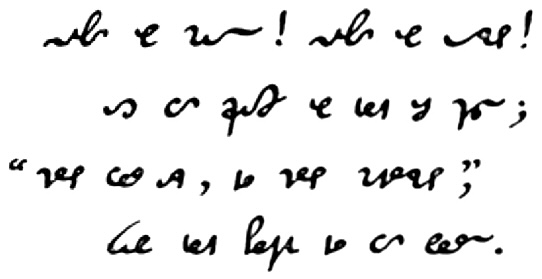
Life is real! life is earnest!
and the grave is not its goal;
“dust thou art, to dust returnest,”
was not spoken to the soul.
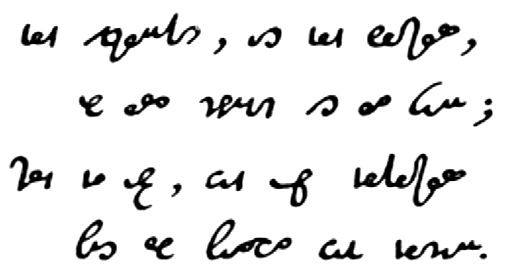
Not enjoyment, and not sorrow,
is our designed end or way;
but to act, that each to-morrow
find us farther than to-day.
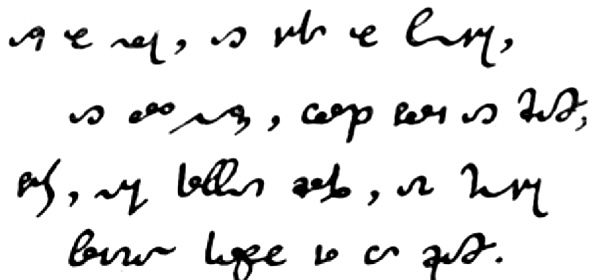
Art is long, and time is fleeting,
and our hearts, though stout and brave,
still, like muffled drums, are beating
funeral marches to the grave.
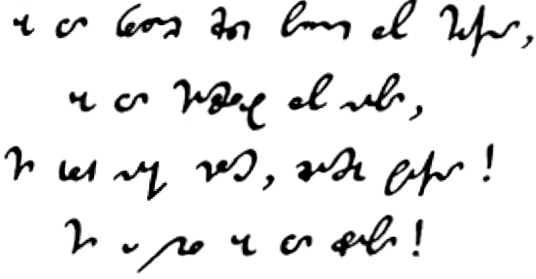
In the world’s broad field of battle,
in the bivouac of life,
be not like dumb, driven cattle!
be a hero in the strife!
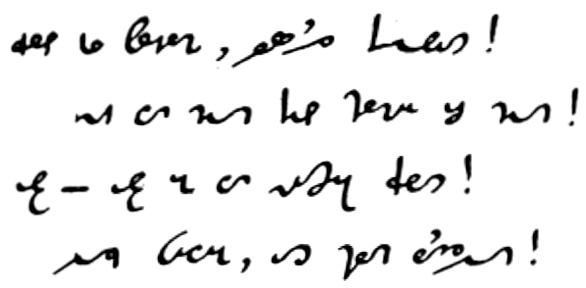
Trust no future, howe’er pleasant!
let the dead past bury its dead!
act — act in the living present!
heart within, and God o’erhead!
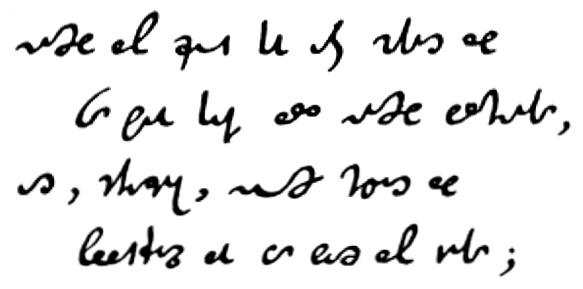
Lives of great men all remind us,
we can make our lives sublime,
and, departing, leave behind us
footprints on the sands of time;
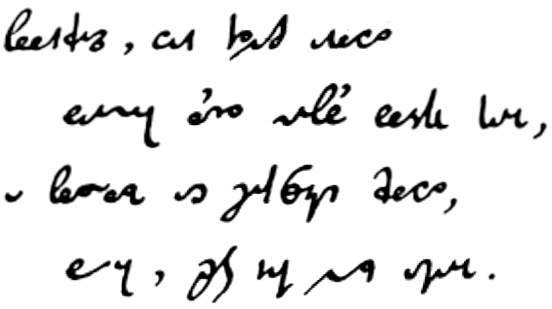
footprints, that perhaps another,
sailing o’er life’s solemn main,
a forlorn and shipwrecked brother,
seeing, shall take heart again.
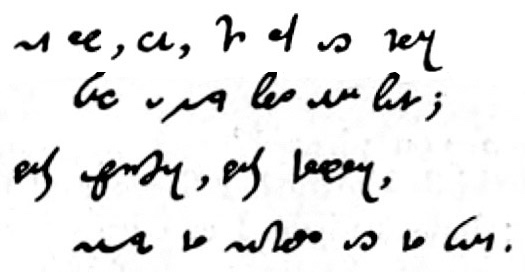
Let us, then, be up and doing
with a heart for any fate;
still achieving, still pursuing,
learn to labour and to wait.
The House-Dog and the Wolf
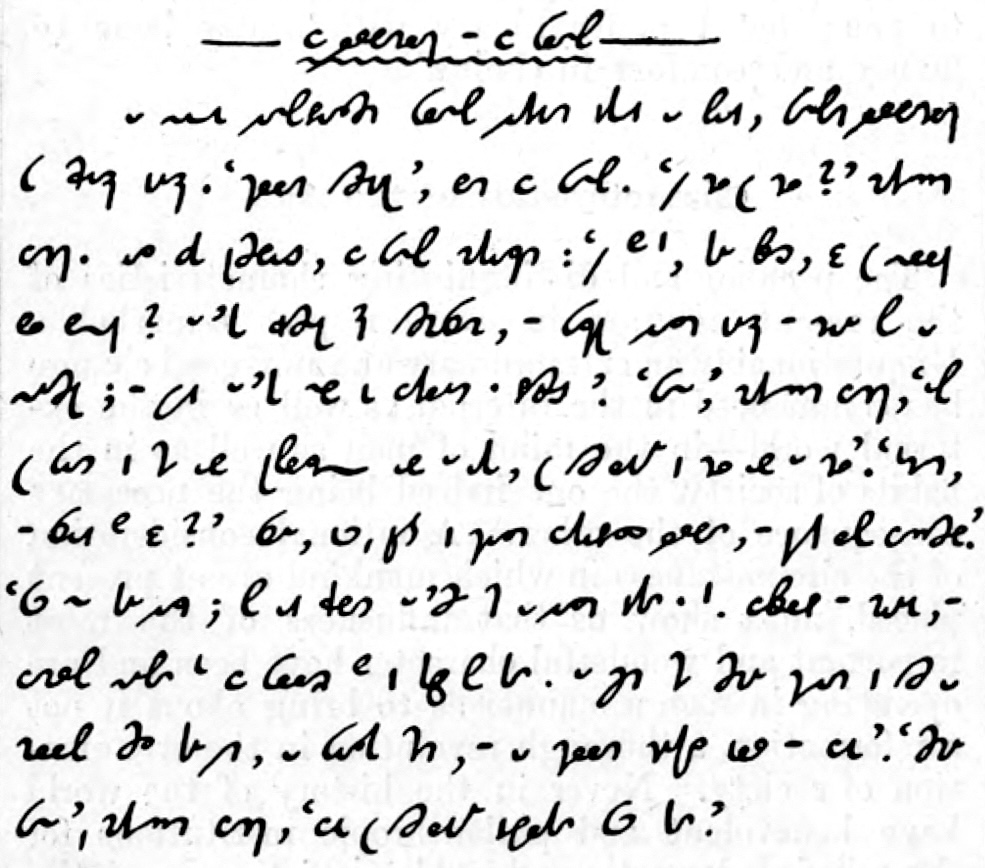
A lean half-starved wolf happened to meet a fat, well-fed house-dog one bright night. ‘Good evening,’ said the wolf. ‘How do you do?’ replied the dog. After some conversation, the wolf remarked: ‘How is it, my friend, that you look so sleek? I’m travelling about everywhere, and working hard night and day for a living, and yet I’m always on the point of starvation.’ ‘Well,’ replied the dog, if you want to be as comfortable as I am, you have only to do as I do.’ ‘Indeed, and what is that?’ ‘Why, nothing, except to guard the master’s house, and keep off thieves.’ ‘With all my heart; for at present I’ve but a hard time of it. The frost and rain, and the rough life in the woods is too much for me. I should be very glad fo have a roof over my head, a warm bed, and a good dinner now and then?’ ‘Very well,’ replied the dog, ‘then you have only to come with me.’

As they were walking along together, the wolf happened to notice a mark round his friend’s neck. ‘What is that mark on your neck, if you please?’ ‘Oh, nothing at all,’ said the dog. ‘Nay; but do tell me.’ ‘Pooh! just a trifle; it is the mark of the collar my chain is fastened to.’ ‘Chain! you don’t mean to say
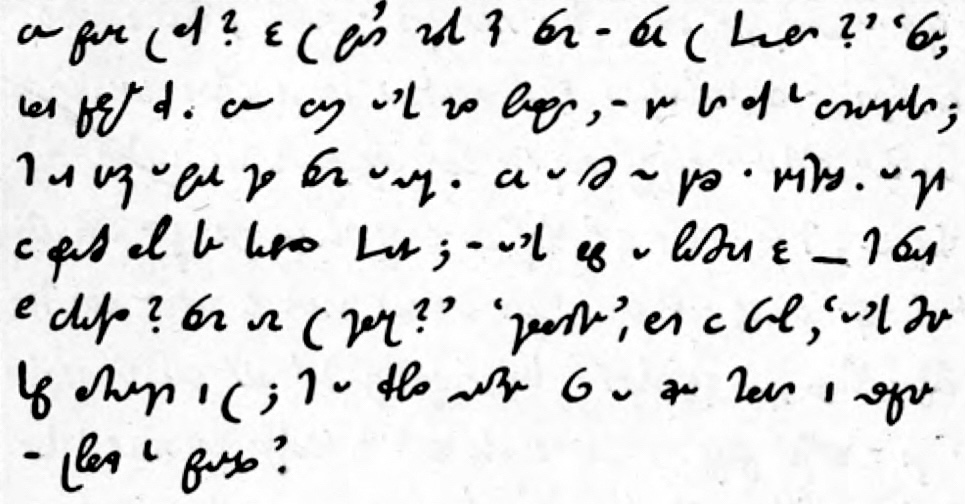
they chain you up? that you can’t roam about where and when you please?’ ‘Why, not exactly perhaps. They think I’m rather fierce, and tie me up in the daytime; but at night I can go where I like. Then I have all kind of titbits. I get the scraps off my master’s plate; and I’m such a favourite that — but what is the matter? where are you going?’ ‘Good-bye,’ said the wolf, ‘I’m very much obliged to you; but I prefer liberty with a dry bone to luxury and comfort in chains.’
Characteristics of the Age
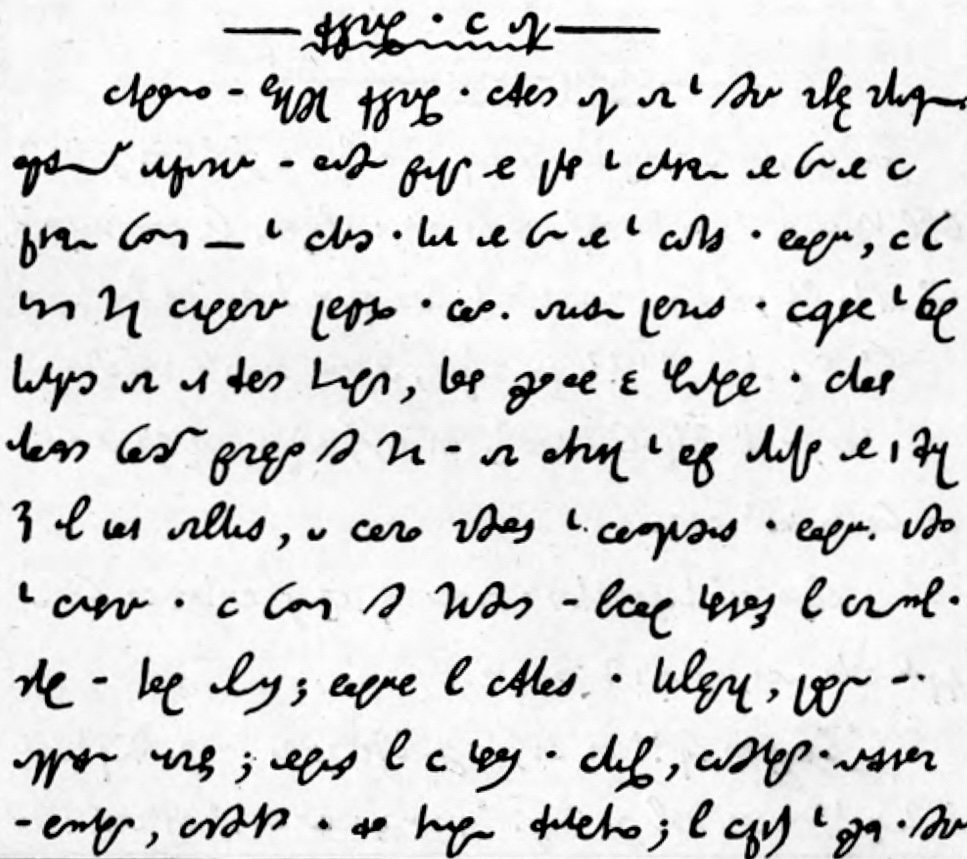
The peculiar and distinguishing characteristics of the present age are in every respect remarkable. Unquestionably an extraordinary and universal change has commenced in the internal as well as in the external world — in the mind of man as well as in the habits of society, the one indeed being the necessary consequence of the other. A rational consideration of the circumstances in which mankind are at present placed, must show us that influences of the most important and wonderful character have been and are operating in such a manner as to bring about if not a reformation, a thorough revolution in the organization of society. Never in the history of the world have benevolent and philanthropic institutions for the relief of domestic and public affliction; societies for the promotion of manufacturing, commercial and agricultural interests; associations for the instruction of the masses, the advancement of literature and science, the development of true political principles; for the extension, in short, of every
[Here the transcription abruptly ends, though the specimen continues for another half a page.]
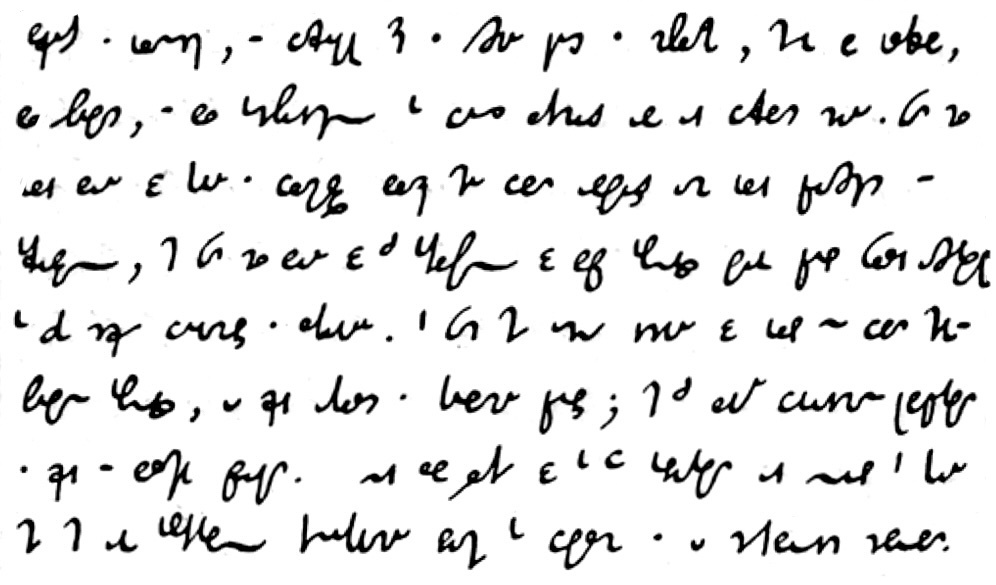
The Darning-Needle
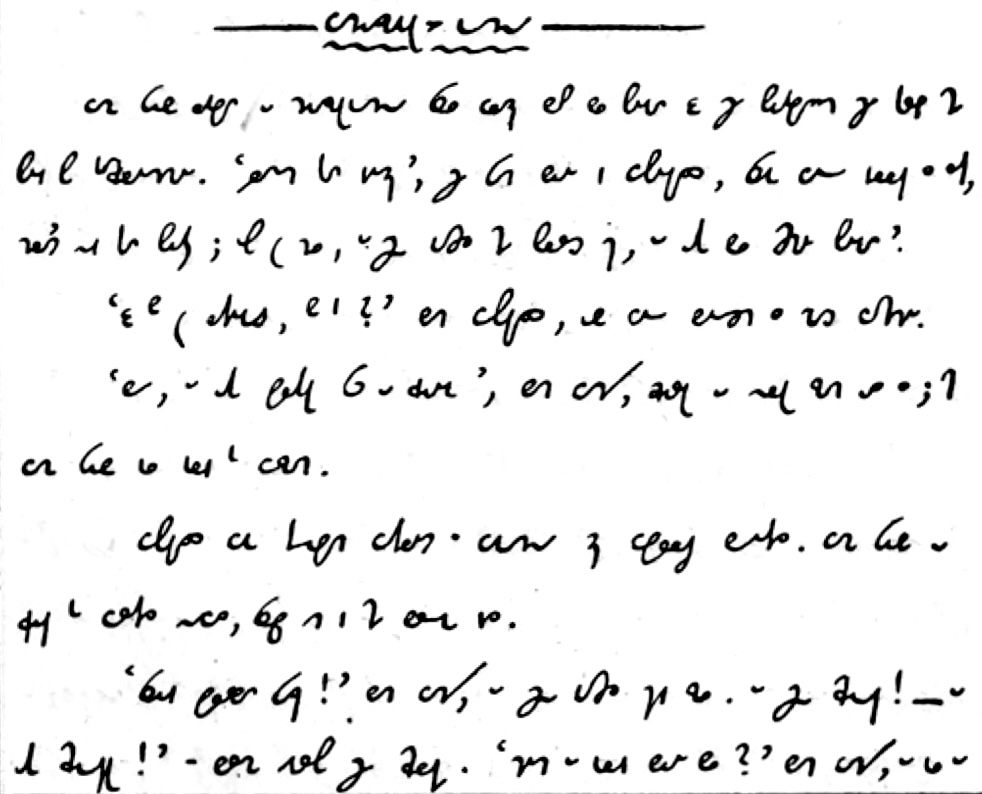
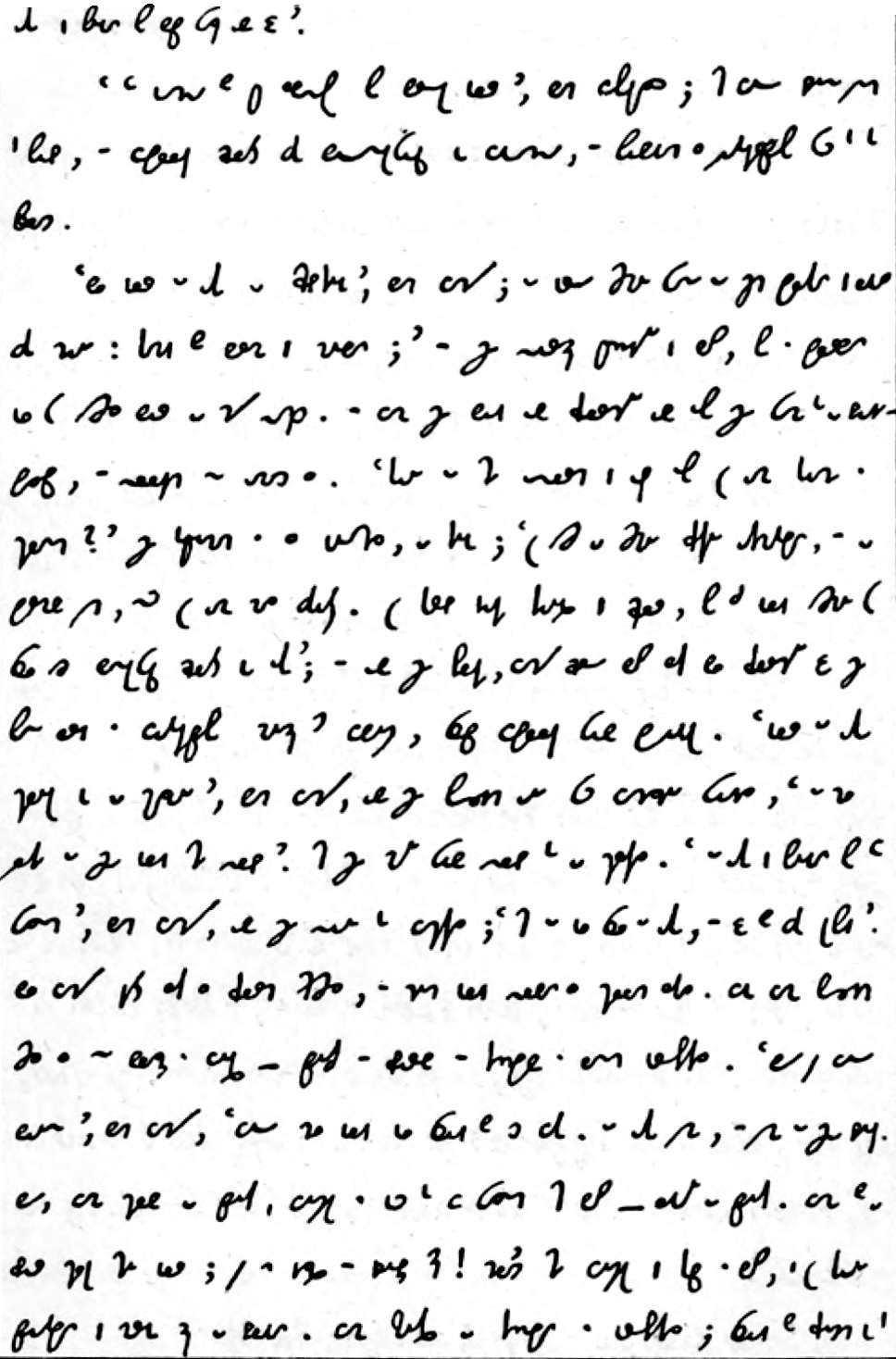
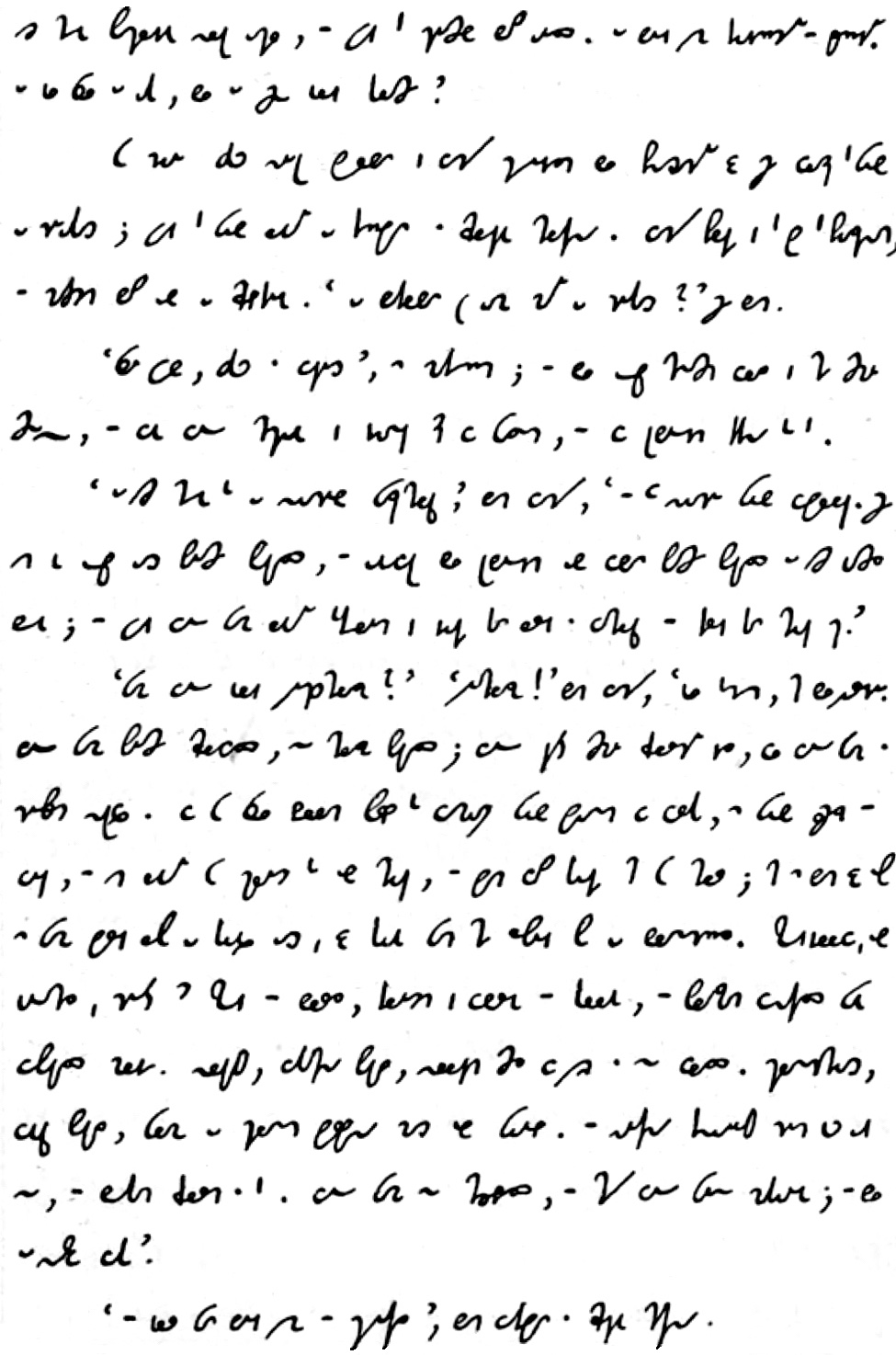
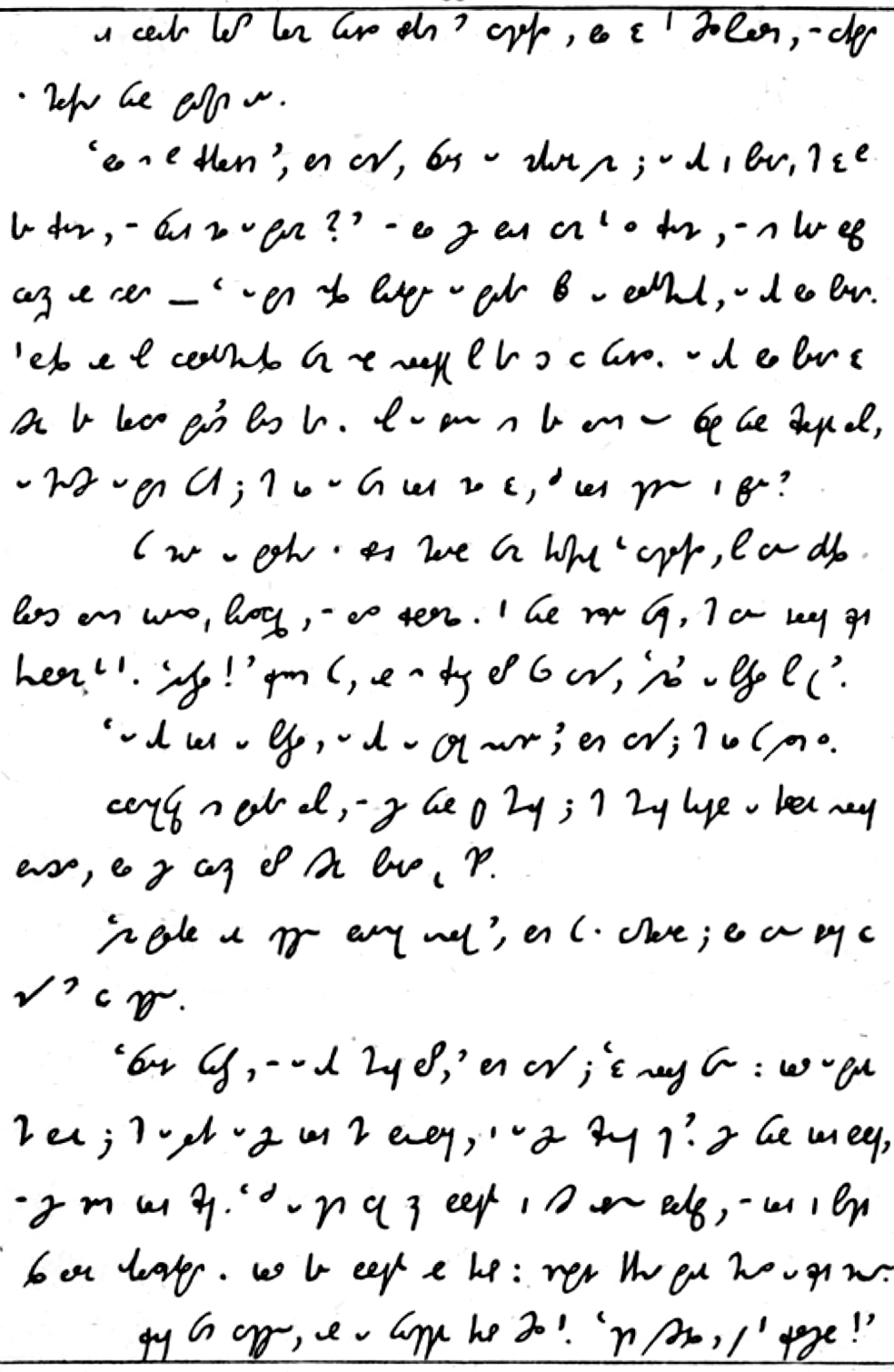

Celtic and Old English Literature
